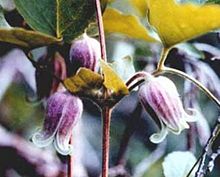- Clematis morefieldii
-
Clematis morefieldii 
Conservation status Scientific classification Kingdom: Plantae (unranked): Angiosperms (unranked): Eudicots Order: Ranunculales Family: Ranunculaceae Genus: Clematis Species: C. morefieldii Binomial name Clematis morefieldii
KralClematis morefieldii is a rare species of flowering plant in the buttercup family known by the common names Morefield's leather flower and Huntsville vasevine. It is native to northern Alabama and southern Tennessee, where it is known from about 22 populations, most of which are small.[1] Many of the populations are threatened and some have been recently extirpated.[1] It is a federally listed endangered species.[2]
This plant was discovered in 1982 in a vacant lot on Round Top Mountain in Madison County, Alabama, by 21-year-old botany student James Morefield.[3][4] It was described as a new species in 1987 and named for him.[2][5] The plant was believed to be an Alabama endemic when it was given endangered status in 1992.[2] Collections were later made in adjacent southern Tennessee.[1] It grows in wooded habitat dominated by smoketree (Cotinus obovatus), often near streams or seeps. It is a climbing plant which attaches to shrubs and rocks for support.[2] The limestone substrate is very rocky with large boulders.[6]
This plant produces woolly-haired vines up to five meters long. The leaves are compound, each made up of several leaflets and one or more tendrils for grabbing objects around the plant. The leaflets have velvety undersides. The inflorescences occur in the axils of the leaves. Each has up to five flowers which have green-tinged pink sepals with curling tips arranged in an urn shape. The flower is thick and hairy in texture. There are no petals. The flower is up to 2.5 centimeters in length and yields fruits which may reach 3.5 centimeters long including their plume-like tips.[7]
When the plant was nominated for endangered status it was only known from five sites, each less than an acre wide, one with only a single plant. About 55% of the total population was located on land scheduled for construction; this area on the outskirts of Huntsville was experiencing significant expansion. Three other sites were believed to have been destroyed recently. Threats listed at the time included construction and maintenance of roads, residential development, herbicides, and potentially the collection of specimens by wildflower enthusiasts and horticulturalists.[2] By 2010 there were over 20 populations known but the plant was determined to still warrant endangered status. Several populations are in protected areas such as nature preserves, but some are clinging to fragments of habitat with development growing around them. Most of the same threats remain, with the additional threats of quarrying activity for one Tennessee population and logging and non-native plant species such as exotic honeysuckles (Lonicera spp.) in Alabama. Wildflower collecting is not believed to be a problem today. The small sizes of the individual populations make their extirpation more likely.[1]
More research is required regarding the life history of this plant and its ecology, including potentially damaging insects that may attack it.[1]
References
- ^ a b c d e USFWS. Clematis morefieldii Five-year Review. September 2007.
- ^ a b c d e USFWS. Endangered status determined for the plant Clematis morefieldii (Morefield's leather flower. Federal Register May 20, 1992.
- ^ Milius, S. Unknown plants under our noses. Science News January 2, 1999.
- ^ Tangley, L. Flowering finds in our own backyards. National Wildlife Dec-Jan 2000.
- ^ Kral, R. (1987). A new "Viorna" Clematis from northern Alabama. Annals of the Missouri Botanical Garden 74(3) 665.
- ^ Clematis morefieldii. The Nature Conservancy.
- ^ Clematis morefieldii. Flora of North America.
Categories:- NatureServe Imperiled species
- Clematis
- Flora of Alabama
- Flora of Tennessee
- Plants described in 1987
Wikimedia Foundation. 2010.

